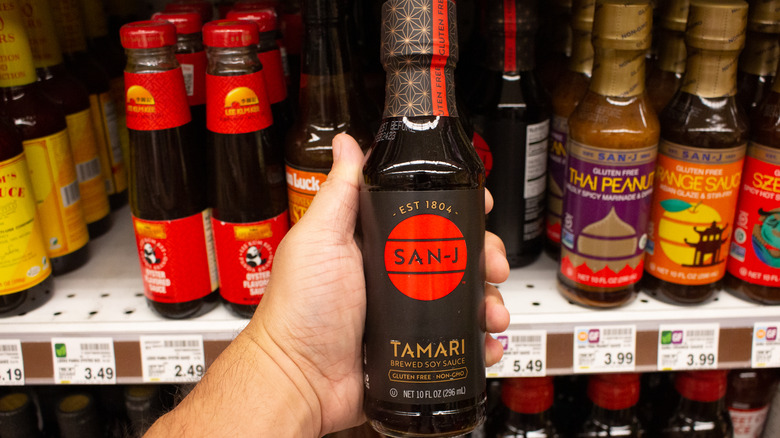Soy Sauce Vs Tamari: What's The Difference?
With its roots dating back over 2,000 years in China, soy sauce may just be the oldest condiment in the cupboard (save for literal salt of the earth, perhaps?). While there's zero doubt you've come across it at some point, you may not be aware there are actually several different types of soy sauce. A staple of Asian cuisine, you're probably most familiar with that beloved bottle donning the little red cap that has a permanent spot on the table at your favorite sushi or Chinese joint (via Saveur).
One of the historically lesser known varieties, tamari, is quickly gaining popularity and grocery shelf real estate hanging out right next to the established brands of the classic soy sauces. You may have even come across it as an option on the table or menu at restaurants by now — and odds are you are under the impression that it is somehow healthier than soy sauce. Well, is it? What is tamari all about, and how does it differ from that trusty old ergonomically-shaped standard bottle?
Subtle yet significant
Tamari is a type of soy sauce mostly produced in Japan. The main difference between other soy sauces and tamari can be summed up in one word — gluten. The vast majority of tamari is gluten-free while other soy sauce is not (though some tamari may contain trace amounts — up to 10% — of gluten, per the Journal of Agricultural and Food Chemistry). While both are made from soybeans, wheat is added to soy sauce, whereas tamari is a byproduct of miso paste and is derived mostly from just the beans.
The higher concentration of soybeans in tamari results in a slightly smoother taste and darker color than soy sauce, while the addition of wheat to the soy sauce lends a subtle sweetness. Aside from those slight differences, the two may be interchangeable in recipes and as a condiment depending on your taste preferences.
Is one a better alternative over the other? Nope. It's really just a personal choice as to whether you want to avoid gluten and have a slightly fuller flavor from the tamari, or stay loyal to your old friend and his little red cap (via San-J).

